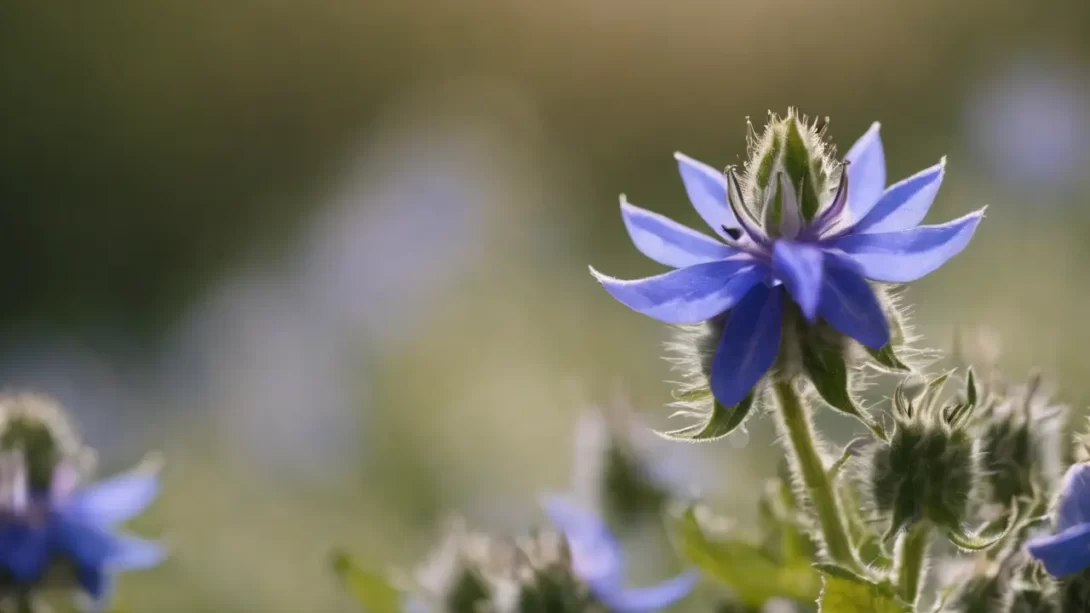Borage, known for its striking blue flowers and culinary uses, is a popular choice for gardeners seeking to enhance their garden’s aesthetics and functionality. However, successful gardening often involves understanding the relationships between different plants, particularly in companion planting. This article aims to guide gardeners on what not to plant alongside borage, ensuring a harmonious and productive garden ecosystem.
Borage
Borago officinalis, commonly known as borage, is a hardy annual herb renowned for its star-shaped blue flowers and fuzzy leaves. It’s a favorite in gardens for its ability to attract beneficial pollinators like bees and for its role in soil conditioning. Borage is also noted for its culinary and medicinal properties, with leaves and flowers used in salads, drinks, and as garnishes. However, its growth habits and requirements mean that it does not coexist well with all plants, making the selection of its companions an important consideration.
Principles of Companion Planting
Companion planting is a strategic approach to gardening where different plants are grown together for mutual benefit. It can enhance plant growth, control pests naturally, and maximize the productivity of the garden space. Key factors in companion planting include understanding the nutrient needs of different plants, their root systems and growth patterns, and how they might impact each other’s development. For instance, some plants may compete for the same nutrients, while others might attract beneficial insects that aid in the growth of their neighbors.
Plants to Avoid Planting with Borage
When planting borage, certain plants should be avoided to maintain garden health and balance. These incompatibilities can be due to various reasons, including different watering needs, nutrient competition, or the potential to attract harmful pests. For example, plants that require a drier soil environment may not thrive next to borage, which prefers more moisture. Additionally, plants that are prone to the same pests as borage should be avoided to prevent exacerbating pest problems. The following section will detail specific plants that should not be grown alongside borage and explain the reasoning behind these recommendations.
Specific Plant Categories to Avoid
When considering companion plants for borage, there are certain categories of plants that generally do not fare well when grown in close proximity. These include:
- Root Vegetables: Root crops like carrots and potatoes may not be ideal companions for borage. Borage has a deep root system that can compete with these vegetables for nutrients and space. Additionally, the dense foliage of borage can overshadow smaller root vegetables, limiting their sunlight exposure.
- Competitive Climbers: Plants that are aggressive climbers or spreaders might not be suitable companions for borage. Vines such as ivy or certain types of beans can overwhelm borage plants, leading to competition for support and light.
- Plants with Contrasting Growing Conditions: Plants that require significantly different growing conditions compared to borage might struggle when planted together. For example, plants that prefer acidic soil or very dry conditions might not thrive alongside borage, which prefers a more neutral pH and consistent moisture.
Allelopathy
Allelopathy refers to the chemical inhibition of one plant by another due to the release of toxic substances. While borage is generally recognized as a beneficial plant in the garden, there is potential for allelopathic interactions with certain plants. It’s important to be aware of this possibility and observe how different plants respond to being in close proximity to borage. If negative growth patterns or signs of stress are observed in plants near borage, consider relocating them to a different part of the garden.
Alternative Companion Plants for Borage
Fortunately, there are numerous plants that do thrive when planted with borage. These include:
- Tomatoes and Peppers: Borage is known to improve the growth and flavor of these plants. It can also help deter tomato hornworms.
- Strawberries: Borage enhances the growth of strawberry plants and can help ward off pests.
- Cucumbers and Squashes: Borage is beneficial for these plants as well, improving their overall health and resistance to pests.
Exploring Compatible Plants with Borage
While certain plants should be avoided, many others can benefit greatly from being planted alongside borage. These compatible plants not only coexist peacefully but often thrive due to the mutual benefits they share:
- Leafy Greens and Brassicas: Plants like spinach, lettuce, and members of the cabbage family benefit from borage’s ability to deter certain pests and attract beneficial insects. The presence of borage can enhance the overall health and yield of these vegetables.
- Legumes: Beans and peas can be good companions for borage. Borage helps in improving the soil quality, which benefits these nitrogen-fixing plants. Additionally, the flowers of borage attract pollinators that are beneficial for the flowering and pod setting in legumes.
- Herbs: Many herbs, including basil and oregano, can be planted with borage. These combinations can create a diverse ecosystem that encourages beneficial insects and improves overall plant health.
Best Practices for Planting with Borage
When integrating borage into your garden as part of a companion planting strategy, consider the following best practices:
- Spacing: Ensure that there is adequate space between borage and its companion plants to avoid overcrowding and competition for resources.
- Watering and Soil Requirements: While planning your garden layout, group borage with plants that have similar watering and soil requirements to simplify garden maintenance and promote a healthy growing environment.
- Pest Monitoring: Regularly monitor your garden for pests. Although borage is known for its pest-deterring properties, it’s still important to keep an eye on all your plants and address any issues promptly.
Conclusion
Borage is a versatile and beneficial herb in the garden, but it’s important to be mindful of what you plant alongside it. By avoiding certain plants that may compete with or negatively affect borage and choosing compatible companions, you can create a harmonious and productive garden. Experimenting with different plant combinations and observing their interactions can be a rewarding aspect of gardening. With careful planning and consideration, borage can be a valuable addition to your garden, contributing to both its beauty and bounty.




